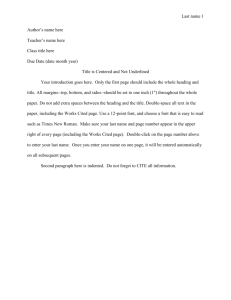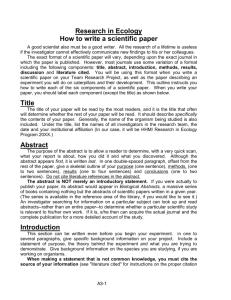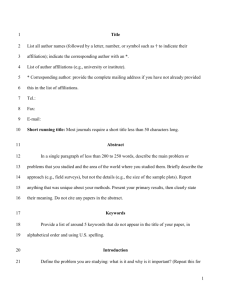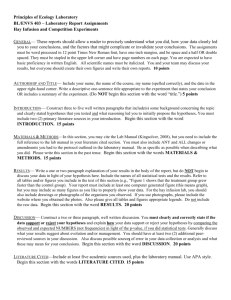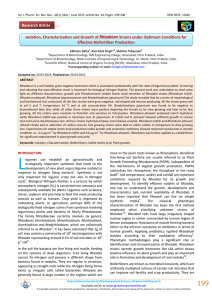Allele Frequency Project Study PowerPoint!!!
advertisement
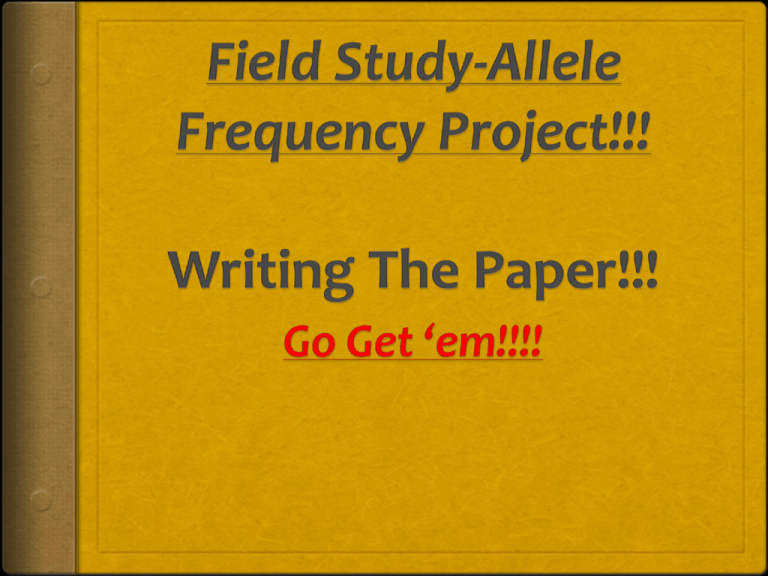
Writing The Paper-Abstract Last! An abstract is a shortened version of the paper and should contain all information necessary for the reader to determine: (1) what the objectives of the study were;(2) how the study was done;(3) what results were obtained;(4) and the significance of the results. Frequently, readers of a scientific journal will only read the abstract, choosing to read at length those papers that are most interesting to them. For this reason, and because abstracts are frequently made available to scientists by various computer abstracting services, this section should be written carefully and succinctly to have the greatest impact in as few words as possible. Although it appears as the first section in a paper, most scientists write the abstract section last. Writing The Paper-First Pages! A well-written scientific paper explains the scientist's motivation for doing an experiment, the experimental design and execution, and the meaning of the results. Scientific papers are written in a style that is exceedingly clear and concise. Their purpose is to inform an audience of other scientists about an important issue and to document the particular approach they used to investigate that issue. Please do not think that good English is not critical in science writing. In fact, scientists try to be so concise that their English should be better than that of workers in other disciplines! If English is not your first language, then proofreading by a native-speaker might be helpful. Writing The Paper-Introduction! Why is this study of scientific interest and what is your objective? This section discusses the results and conclusions of previously published studies, to help explain why the current study is of scientific interest. The Introduction is organized to move from general information to specific information. This background must be summarized succinctly, but it should not be itemized. Take care not to go too far afield in providing background information; limit the introduction to studies that relate directly to the present study. Emphasize your specific contribution to the topic. The last sentences of the introduction should be a statement of objectives and a statement of hypotheses. This will be a good transition to the next section “Methods” in which you will explain how you proceeded to meet your objectives and to test your hypotheses. For example you might write the following: "Our objective was to determine if the relationship between legumes and nitrogen-fixing bacteria is species-specific. We hypothesized that legumes would grow best when infected by the same Rhizobium species that it occurs with in the field.” Writing The Paper-Citations! How to Cite Sources in the Introduction Section? It is important to cite sources in the introduction section of your paper as evidence of the claims you are making. There are ways of citing sources in the text so that the reader can find the full reference in the literature cited section at the end of the paper, yet the flow of the reading is not badly interrupted. Below are some example of how this can be done: "Smith (1983) found that N-fixing plants could be infected by several different species of Rhizobium.” "Walnut trees are known to be allelopathic (Smith 1949, Bond et al. 1955, Jones and Green 1963).“ "Although the presence of Rhizobium normally increases the growth of legumes (Nguyen 1987), the opposite effect has been observed (Washington 1999).“ Note that articles by one or two authors are always cited in the text using their last names. However, if there are more than two authors, the last name of the 1st author is given followed by the abbreviation et al. which is Latin for "and others". The second citation (above) shows that it is acceptable, and encouraged, to cite more than one source for a particular statement. This gives the statement more validity in its context and suggests that your research was thorough. Note also that the three sources are ordered by publication date, so that the earliest citation comes first. Writing The Paper-Methods! This section provides all the methodological details necessary for another scientist to duplicate your work. It should be a narrative of the steps you took in your experiment or study, not a list of instructions such as you might find in a cookbook. You should assume that the other scientist has the same basic skills that you have, but does not know the specific details of your experiment. For example, it is unnecessary to write: "We poured N-free fertilizer solution into a graduated cylinder until the bottom of the meniscus was at the 30 ml line. We poured the fertilizer onto the top of the soil in a pot and then repeated this procedure 24 times. Rather, you would assume that the scientist knows how to measure and add liquids to pots and write: "We added 30 ml of N-free fertilizer to each of 24 pots.” An important part of writing a scientific paper is deciding what bits of information needs to be given in detail. Writing The Paper-Methods, continued In the last paragraph, provide a brief description of statistical tests you used (statistics are methods!). Be sure not to include extraneous information, though, as scientists know all about null hypotheses and when to reject them. Writing The Paper-Results/Data!!! Inferential Statistics Like The Chi 2 Help Determine Research Significance! Writing The Paper-Results/Data! This section presents the results of the experiment but does not attempt to interpret their meaning. As with the Methods section, the trick to writing a good Results section is knowing what information to include or exclude. You will not present the raw data that you collected, but rather you will summarize the data with text, tables and/or figures. Use the text of the paper to state the results of your study, then refer the reader to a table or figure where they can see the data for themselves. For example you may write: "Nitrogen fertilizer significantly increased soy bean total biomass (p=0.05) regardless of the presence or absence of Rhizobium (Table 1).” Writing The PaperResults/Data, continued "The sentence above is well written because: (i) the result of adding nitrogen is stated concisely, (ii) the word significantly is accompanied by the statistical probability level (p=0.05), (iii) the scientific name Rhizobium is italicized, and (iv) the reader is referred to a table where the data to support the statement can be found. Note that the measurement (total biomass, in this case) is mentioned. You must explicitly state the measure you are using. Writing The PaperResults/Data, continued Do not include the same data in both a table and a figure. It is best to present the data in a table unless there is visual information that can be gained by using a figure. For example, a figure is useful for reporting a regression analysis (line graph), or comparing the several treatment levels (bar graph with error bars). Each table and figure has several lines of text in the legend (or caption) that explain the information that is being presented; this is, they are made to stand alone. A table's legend appears above it, while the legend for a figure appears below the figure. See examples: a table and a figure. If your table includes the results of a statistical analysis, be sure to provide the information necessary for the reader to properly evaluate the analysis (probability levels, degrees of freedom, sample size, etc.). Writing The PaperResults/Data, continued Additional tips on the Results section: Number tables and figures separately beginning with 1 (i.e. Table 1, Table 2, Figure 1, etc.). Do not attempt to evaluate the results in this section. Report only what you found; hold all discussion of the significance of the results for the Discussion section. It is not necessary to describe every step of your statistical analyses. Scientists understand all about null hypotheses, rejection rules, and so forth and do not need to be reminded of them. Just say something like, "Honeybees did not use the flowers in proportion to their availability (X2 = 7.9, p<0.05, d.f.= 4, chisquare test).” Writing The PaperResults/Data, continued Likewise, cite tables and figures without describing in detail how the data were manipulated. Explanations of this sort should appear in a legend or caption written on the same page as the figure or table. You must refer in the text to each figure or table you include in your paper. Tables generally should report summary-level data, such as means ± standard deviations, rather than all your raw data. A long list of all your individual observations will mean much less than a few concise, easy-to-read tables or figures that bring out the main findings of your study. Only use a figure (graph) when the data lend themselves to a good visual representation. Avoid using figures that show too many variables or trends at once, because they can be hard to understand. Writing The PaperDiscussion/Conclusion!!! In this section, you are free to explain what the results mean or why they differ from what other workers have found. You should interpret your results in light of other published results, by adding additional information from sources you cited in the Introduction section as well as by introducing new sources. Discuss the research hypothesis and its acceptance or rejection. Discuss significance found in your research. Make sure you provide accurate citations. Relate your discussion back to the objectives and questions you raised in the Introduction section. However, do not simply re-state the objectives. Make statements that synthesize all the evidence (including previous work and the current work). Writing The PaperDiscussion/Conclusion, continued Do not make statements that are too broad: it is unlikely, for example, that through one Rhizobium-legume experiment, you will discover that there is no symbiosis between the two organisms. Limit your conclusions to those that your data can actually support, such as "We did not find a significant effect of Rhizobium inoculate on soybean biomass in this experiment." You can then proceed to speculate on why this occurred and whether you expected this to occur, based on other workers' findings. Suggest future directions for research, new methods, explanations for deviations from previously published results, etc. If necessary, note problems with the methods and explain anomalies in the data. Do not simply list the problems but provide thoughtful discussion about the implications of the errors in terms of your conclusions. Writing The Paper-Citing Sources! This is the last section of the paper. Here you should provide an alphabetical listing of all the published work you cited in the text of the paper. This does not mean every article you found in your research; only include the works you actually cited in the text of your paper. A standard format is used both to cite literature in the text and to list these studies in the Literature Cited section. Consult McMillan (1988) or a recent issue of Ecology for guidance. Hypothetical examples of the format used in the journal Ecology are below: Djorjevic, M., D.W. Gabriel and B.G. Rolfe. 1987. Rhizobium: Refined parasite of legumes. Annual Review of Phytopathology 25: 145-168. Jones, I. J. and B. J. Green. 1963. Inhibitory agents in walnut trees. Plant Physiology 70:101-152. Writing The Paper-Citing Sources! Notice some of the following details: - the list is alphabetized; - no first or middle names are listed (the author's first and middle initials are used instead); - only the first word in the title of the journal article (except for proper nouns) is capitalized; - different journals use different styles for Literature Cited sections. You should pay careful attention to details of formatting when you write your own Literature Cited section. For papers published in journals you must provide the date, title, journal name, volume number, and page numbers. For books you need the publication date, title, publisher, and place of publication. Writing The Paper-Citing Sources, continued Notice some of the following details: - the list is alphabetized; - no first or middle names are listed (the author's first and middle initials are used instead); - only the first word in the title of the journal article (except for proper nouns) is capitalized; - different journals use different styles for Literature Cited sections. You should pay careful attention to details of formatting when you write your own Literature Cited section. For papers published in journals you must provide the date, title, journal name, volume number, and page numbers. For books you need the publication date, title, publisher, and place of publication. Writing The Paper-Citing Sources, continued What are permissible citations in most Science research writings? Often researchers are required to cite 8 sources from peerreviewed scientific journals. Often one of the sources can be from a text book or a scientific magazine such as Scientific American or Smithsonian. Note that magazine articles do not have the information organized into sections (e.g. abstract, introduction, methods, etc.) and thus they may not be used. You cannot cite web sites unless they are peer-reviewed, archived online publications.

